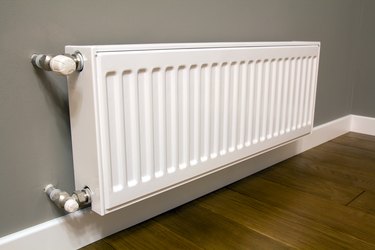
Old homes are full of mysteries, which is fun when you're exploring a secret nook but not so fun when you're dealing with a malfunctioning radiator. Knowing whether it's a steam radiator or hot water radiator may be relevant if you need to make repairs, but it can be hard to tell at a glance. Steam radiators and hot water radiators work in similar ways, and they look similar too. There are a few key signs that will tell you which type is heating your home.
How Steam and Water Radiators Work
Video of the Day
Steam radiators worked as an early home heating system because this kind of system is quite simple. When you turn on the radiator, water is heated in a boiler until it creates hot steam, which travels up through pipes and into radiators that diffuse heat and warm the room. As steam cools, it condenses back into water and travels back down the pipes to the boiler.
Video of the Day
This system doesn't require pumps since steam travels freely through pipes. Of course, that's also one of the drawbacks of steam radiators: It's hard to control how steam moves through a system of pipes, especially if there are any gaps in the pipes. This is why homes with steam radiators sometimes have problems with uneven heating; adjusting steam heat is notoriously difficult.
A hot water radiator works in a very similar way to a steam radiator but with one key difference. Instead of creating steam, the boiler heats water until it's very hot, and then that water is pumped up through the pipes and circulates through radiators. Cooled water is returned to the boiler via a pipe so it can be reheated.
Identifying a Steam Radiator
The number of pipes connecting to the radiator may give you a good idea of whether it uses steam or hot water. A steam radiator will commonly have just one pipe, which both delivers the steam and carries condensed water back to the boiler. However, there are some steam radiators that do use two pipes, so this isn't a foolproof way to distinguish between the types.
If the floor below the heater is slightly warped, it's very possible that you have a steam radiator. Years of exposure to hot steam can damage flooring. Steam radiators may also make a distinct whistling noise. Finally, the boiler of a steam system should have a sight glass attached. It's a narrow glass tube that's installed vertically to the boiler and is used to check the water level.
Identifying a Hot Water Radiator
As with steam radiators, hot water radiators have a few distinct characteristics. For one, a hot water radiator should have a small valve somewhere. Opening this valve allows you to bleed the radiator, letting trapped air escape the system. This is an important part of radiator maintenance, and it's a simple process. You may be able to open the valve with just your fingers, though with certain models, you may need a wrench or flathead screwdriver to turn the valve. (Even then, an old radiator valve may be stubbornly stuck shut; applying a squirt of multipurpose lubricant should smooth the way.)
Looking at the boiler may help too. If you see a pump attached to the unit, it's a hot water system. Sound may also help you identify a hot water radiator. If you can hear the sound of water rushing through the unit when the heat is on, you can be confident about what type of system you have.